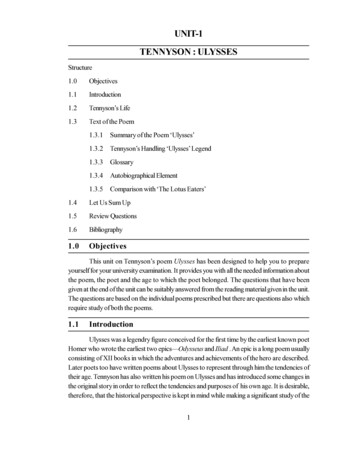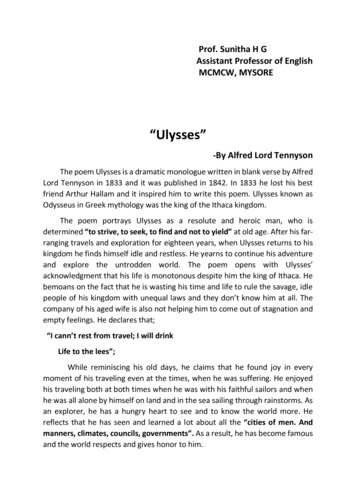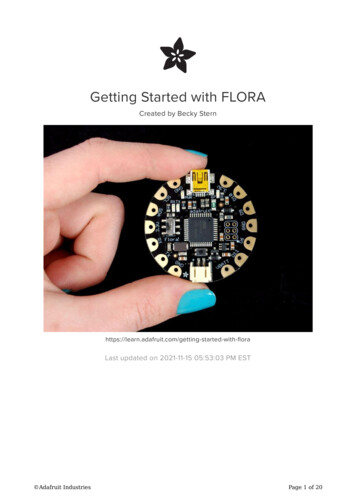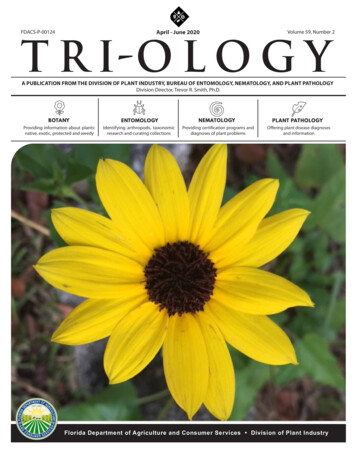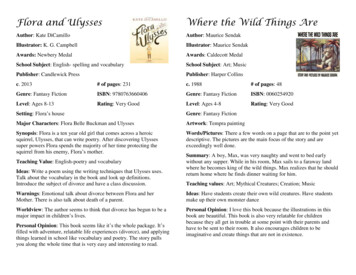
Transcription
Flora and UlyssesWhere the Wild Things AreAuthor: Kate DiCamilloAuthor: Maurice SendakIllustrator: K. G. CampbellIllustrator: Maurice SendakAwards: Newbery MedalAwards: Caldecott MedalSchool Subject: English- spelling and vocabularySchool Subject: Art; MusicPublisher: Candlewick PressPublisher: Harper Collinsc. 2013# of pages: 231c. 1988# of pages: 48Genre: Fantasy FictionISBN: 9780763660406Genre: Fantasy FictionISBN: 0060254920Level: Ages 8-13Rating: Very GoodLevel: Ages 4-8Rating: Very GoodSetting: Flora’s houseGenre: Fantasy FictionMajor Characters: Flora Belle Buckman and UlyssesArtwork: Tempra paintingSynopsis: Flora is a ten year old girl that comes across a heroicsquirrel, Ulysses, that can write poetry. After discovering Ulyssessuper powers Flora spends the majority of her time protecting thesquirrel from his enemy, Flora’s mother.Words/Pictures: There a few words on a page that are to the point yetdescriptive. The pictures are the main focus of the story and areexceedingly well done.Teaching Value: English-poetry and vocabularyIdeas: Write a poem using the writing techniques that Ulysses uses.Talk about the vocabulary in the book and look up definitions.Introduce the subject of divorce and have a class discussion.Summary: A boy, Max, was very naughty and went to bed earlywithout any supper. While in his room, Max sails to a faraway landwhere he becomes king of the wild things. Max realizes that he shouldreturn home where he finds dinner waiting for him.Teaching values: Art; Mythical Creatures; Creation; MusicWarnings: Emotional talk about divorce between Flora and herMother. There is also talk about death of a parent.Ideas: Have students create their own wild creatures. Have studentsmake up their own monster danceWorldview: The author seems to think that divorce has begun to be amajor impact in children’s lives.Personal Opinion: I love this book because the illustrations in thisbook are beautiful. This book is also very relatable for childrenbecause they all get in trouble at some point with their parents andhave to be sent to their room. It also encourages children to beimaginative and create things that are not in existence.Personal Opinion: This book seems like it’s the whole package. It’sfilled with adventure, relatable life experiences (divorce), and applyingthings learned in school like vocabulary and poetry. The story pullsyou along the whole time that is very easy and interesting to read.
The PolarExpressStone FoxAuthor: Chris Van AllsburgIllustrator: Marcia SewallIllustrator: Chris Van AllsburgAward: NoneAwards: CaldecottSchool Subject: HistorySchool Subject: Literature; Holiday; ReligionPublisher: Scholastic Inc.Publisher: Houghton Mifflinc. 1980# of pages: 81Author: John Reynoldsc. 1985# of pages: 32Genre: Historical FictionISBN: 0439095107Genre: Adventure FictionISBN: 9780395389492Level: Ages 8-10Rating: GoodLevel: Ages 3-9Rating: ExcellentSetting: A farm in WyomingArtwork: Oil paintingWords/ Pictures: Some challenging words. Very descriptive wordsand there are not too many on a page so older kids could read on theirown. The pictures are beautiful and elaborate on the text.Summary: A boy wakes up in the middle of the night to find amagical train waiting for him. The train is filled with children on theirway to the North Pole to meet Santa. Santa meets the boy and giveshim the first gift of Christmas, a bell. The boy loses the bell but Santareturns the bell to him Christmas day. Only the boy and his sister canhear the bell because they are the only ones who believe in Santa.Teaching Values: Religion-beliefsIdeas: Have them draw or talk about what they would want as the firstgift of Christmas.Personal Opinion: This is a book every child should read at somepoint. It gets you in the Christmas spirit and is a beautiful book to read.Misc: Talk to children about how they could relate believing in Santaand having the bell ring, to believing in Christ.Synopsis: A little boy’s grandfather got depressed because thegrandfather was very deep in debt. The little boy decides to take itupon himself to get the money to pay his grandfather’s debt.Teaching Values: History; Native Americans; PerseveranceIdeas: Write an alternative ending to a story. Talk about the history ofNative Americans in regards to the story.Warnings: Sudden death at the endWorldview: The author has a respect for women and puts them in aposition of authority (doctor). He also has a respect for differentcultures (Native American).Personal Opinion: I really liked this book because of how the boywas able to step into the role of provider for him and his grandfather.The only part I did not like was when the dog’s heart explodedbecause the story ended very abruptly.
Nancy Drew and the ClueCrew: Small VolcanoesThe Adventures of HuckleberryFinnAuthor(s): Sarah Kinney & Stefan PetruchaAuthor: Mark TwainIllustrators(s): Stan Goldberg & Laurie E. SmithAwards: NoneAwards: NoneSchool Subject: HistorySubject: SciencePublisher: DoverPublisher: Papercutzc. 2012c.1994# of pages: 220# of pages: 63Genre: Historical Fiction; AdventureISBN: 9781597073554Level: 10-16Level: Ages 6-9Rating: GoodISBN: 0486280616Rating: Very GoodSetting: 1800’s on the Mississippi River in St. Petersburg, MissouriGenre: MysteryMajor Characters: Huckleberry Finn and Jim the slaveArtwork: CartoonSynopsis: Huck Finn ran away from his house to escape his abusivefather. Along the way he runs into Jim who is trying to become a freeslave. The rest of the book is about the adventures the two boys comeacross on their way to freedom.Words/ Pictures: Lots of pictures. Minimal words per pageSummary: Nancy Drew and her friends have to turn in a scienceproject. The day before it’s due, all of her classmates’ science projectsgo missing. Now Nancy and her friends must completer their scienceproject and find the missing ones.Teaching Values: Earth Science; working together; solving problemsIdeas: Make a volcano like the ones in the book. Talk about how towork efficiently with our peers.Personal Opinion: This book had great illustrations and the story wasgreat. I do not know if I would make this book into a lesson.Teaching Value: History; RacismIdeas: Talk about the independence of Huck. Talk about the history ofAfrican American slaves and their escape for freedom.Worldview: Mark Twain focuses on the civil and uncivilized worldsand compares to the two and exposes their flaws.Warnings: Exceedingly racistPersonal Opinion: Classic piece of literature that students should beexposed to. It is an accurate depiction of how things were in the 1800s.Along with being educational it is entertaining because it is filled withadventure.
To Kill a MockingbirdOliviaAuthor: Harper LeeAuthor: Ian FalconerAwards: Pulitzer PrizeIllustrated: Ian FalconerSchool Subject: HistoryAwards: Caldecott HonorPublisher: Grand Central PublishingSubject: Literaturec. 1960#of pages: 384Publisher: Scholastic Inc.Genre: Historical FictionISBN: 9780446310789c. 2000# of pages: 40Level: 13-17Rating: Very GoodGenre: Fiction; fantasyISBN: 0439319048Setting: 1930’s Alabama on a farmLevel: Ages 3-6Rating: Very GoodMajor Characters: Scout and JemArtwork: Charcoal picturesSynopsis: Scout and Jem have a mysterious neighbor that they trynumerous times for many years to meet. They’ve heard many rumorsabout him, not all good. The kids find out near the end that theirneighbor has been doing them favors throughout their lives and hasknown who they are all along.Words/Pictures: Mostly pictures, not too many wordsTeaching Values: Great Depression; RacismIdeas: Have students draw a picture of their family or their likes anddislikes. Have them talk about their daily routine.Ideas: Have the students write a defense proposal for the jury based onthe court case. Preform them.Worldview: I think that this author has a good character and isencouraging readers to know others before they judge them.Personal Opinion: I loved this book because there were so manylessons to be learned. The style of writing was so intriguing to me asthe reader and kept me wanting to read more.Summary: Olivia introduces us to her family, shows us her likes anddislikes, and demonstrates her daily routine.Teaching value: relatability; dealing with problemsPersonal Opinion: I really enjoy this book because it is quitehumorous. Young kids will really be able to relate to the character inthis book.
The Ugly DucklingRumpelstiltskinAuthor: Hans Christian AndersenAuthor: Paul O. ZelinskyIllustrator: Jerry PinkneyIllustrator: Paul O. ZelinskyAwards: CaldecottAwards: CaldecottSubject: Bullying; Self-worth; Animal scienceSubject: FairytalesPublisher: Morrow Junior BooksPublisher: Duttonc. 1999c. 1986# of pages: 40Genre: Fairy TaleISBN: 0525442650Level: Ages 4-10Rating: Good#of pages: 40Genre: Fiction; Adventure; Fairy TalesLevel: Ages 4-8ISBN: 0688159320Rating: ExcellentArtwork: WatercolorsArtwork: Renaissance oil paintingWords/Pictures: Fair amount of words but not too overwhelmingWords/Pictures: Fair amount of wordsSummary: A swan is born into a family of ducks. The other duckspick on the swan, making him decide to leave. The swan wondersaround trying to find where he fits in. Eventually he comes across agroup of swans that look just like him and the swan no longer feelsugly.Summary: A king forces a girl to turn straw into gold, otherwise hewould kill her. Then a little man came and spun the straw into gold atthe expense of a possession of the girls. The girl runs out of things togive the man so she promises her first born to him. The girl then mustfind a way to save her child.Teaching Value: Bullying; Self-worth; Differences between birdsTeaching Value: Material things are not important; Do not makepromises you can’t keep.Ideas: Talk about times when you might have felt bullied or didn’tbelong. What did you do? Talk about the differences between birds.Personal Opinion: Great book! The illustrations are beautiful. Giveskids a nice lesson on how the things we say could be hurtful.Ideas: Act it outWarning: Threats of deathPersonal Opinion: The illustrations are great and I love this story.
Joseph Had a Little OverCoatMiss Nelson isMissing!Author: Simms TabackAuthor: Harry AllardIllustrator: Simms TabackIllustrator: James MarshallAwards: CaldecottAwards: NoneSubject: Literature; ScienceSubject: LiteraturePublisher: Penguin GroupPublisher: Houghton Mifflinc. 1999#of pages: 32c. 1977#of pages: 32Genre: FictionISBN: 0670878553Genre: FictionISBN: 9780395252963Level: Ages 3-8Rating: GoodLevel: Ages 5-7Rating: GoodArtwork: Paper collageArtwork: Mostly watercolorWords/ Pictures: Few words with big picturesWords/ Pictures: Not too many words per pageSummary: Joseph has an overcoat that is very old. He recycles itmany times until eventually nothing is left of the coat.Summary: Miss Nelson’s class is very naughty. To solve this problemshe comes to school disguised as a witch as makes the children do lotsof homework. The children begin to miss Ms. Nelson. When MissNelson returns the students are now on their best behavior.Teaching Values: To reuse things; RecycleIdeas: Have them bring something old from home that they don’t useanymore and find a way to recycle it. Make their own story aboutsomething that is recycled and what it turns into.Personal Opinion: This book is really adorable. The illustrations aregreat and very descriptive to the words. Great way to introducerecycling to young children.Teaching Values: Be on your best behavior.Ideas: Class discussion about how different the children’s behaviorwas at the beginning of the book as opposed to the end. Then talkabout which kind of behavior they should have in school. You as theteacher could come to school dressed as the witch.Personal Opinion: I think that this book is hilarious. When the teachercomes back as witch and makes all the kids do homework is veryfunny. I’m sure many teachers have wanted to do something like thatif they have a naughty class.
Alphabet MysteryDavy CrockettAuthor: Audrey WoodAuthor: Larry Dane BrimmerIllustrator: Bruce WoodIllustrator: Donna BergerAward: NoneAward: NoneSubject: EnglishSubject: HistoryPublisher: The Blue Sky PressPublisher: Compass Point Booksc. 2003#of pages: 40c. 2004Genre: Mystery FictionISBN: 0439443377Genre: Folktale; Historical Fiction ISBN: 0756506034Level: Ages 3-5Rating: Very GoodLevel: Ages 6-10#of pages:32Rating: OkayArtwork: Digital 3-D ArtArtwork: Tempra PaintingWords/Pictures: Not a lot of words per page. Main focus is on theillustrationsWords/Pictures: Good amount of words.Summary: The letter “x” goes missing from the alphabet. The otherletters go on a mission to find him.Teaching Values: Teaching lower case lettersIdeas: Have them point out when the capital letters come into thestory. Assign each of the letters to the students and have them draw theletters as if they have a personality.Personal Opinion: I like this book a lot because it is a different way toteach kids about the alphabet.Summary: Series of folktales about Davy Crockett about how hecame to be and some of his accomplishments.Teaching Values: The history of Davy Crockett and the myths thatwere told about him.Ideas: Talk about the real “Davy Crockett” and discuss the differencesbetween the real facts and what’s in the book. Look up some of thewebsites in the back of the book and have the student say one thingthat they found out about Davy Crockett.Personal Opinion: I found this book to be kind of difficult to readbecause it doesn’t pull you along like other stories. The illustrations inthe book are very good. I like that they provide you with activities inthe back of the book.Misc: You may have to go over the vocabulary in the back of the bookso that the children will understand the story.
A Long Way from ChicagoThe PatchAuthor: Richard PeckAuthor: Justina Chen HeadleyAwards: Newbery HonorIllustrator: Mitch VaneSchool Subject: HistoryAward: NonePublisher: ScholasticSubject: Healthc. 1997#of pages: 148Publisher: CharlesbridgeGenre: Historical FictionISBN: 0439240921c. 2006#of pages: 32Genre: FictionISBN: 9781580890496Level: Ages 5- 8Rating: OkayLevel: 11-14Rating: Very GoodSetting: 1929-1942 in IllinoisMajor Characters: Mary Alice, Joey, GrandmaSynopsis: Mary Alice and Joey go to their Grandma’s house for oneweek every summer. Their Grandma takes them on crazy adventuresand influences them with her different mannerisms.Teaching Values: Great DepressionIdeas: Talk about the history of the Great Depression. What didGrandma do to cope with the depression?Worldview: The author is a feminist because the grandma isindependent. The author must also have strong morals.Personal Opinion: I loved this story. There were so many adventuresthat Grandma took the kids on. As you read you can watch the kidsadmiration for their grandma grow when she takes them on theadventures.Artwork: Watercolor and dip pen in India inkWords/Picture: Easy words and there are kind of a lot on a pageSummary: Becca gets diagnosed with amblyopia after her birthday.She has to wear an eye patch to correct her lazy eye. Becca is afraidthat her peers will make fun of her so she says that she is a pirate.Eventually her teacher makes her tell the class why she is wearing hereye patch and her friends are very accepting of her lazy eye.Teaching Value: Bullying people with disabilities; Informing abouteye disordersIdeas: Read the back of the book to define what amblyopia is.Personal Opinion: I was indifferent about this book because it’sgeared toward younger kids but I don’t know if they would understanda lazy eye. The story seemed like it was trying to be informative andtolerable of others disabilities.
Duck & GooseAuthor: Tad HillsIllustrator: Tad HillsThe Day theCrayons QuitAuthor: Drew DaywaltAwards: NoneIllustrator: Oliver JeffersSchool Subject: Animal SciencePublisher: Schwartz & Wade Booksc. 2006#of pages: 40Genre: FictionISBN: 037583611Level: Ages 3-7Rating: Very GoodArtwork: Oil PaintWords/Pictures: Words are very descriptive and simple.Summary: Duck and goose come across what they think is an egg.They argue about who gets to keep it and raise it. Through theirarguing they realize that they could raise the bird together. In the end,they figure out that the egg is not an egg, it’s a ball.Teaching Values: Animal Science; Working TogetherIdeas: Students could discuss what kind of birds come from whichkind of eggs. Class discussion about working together. If the ball wasan egg what kind of bird would come out of it? Draw what it lookslike.Personal Opinion: The illustrations in this book are absolutelyadorable. It has a good lesson about how its better when you worktogether.Misc: Could be a good book for young readers to try and read on theirown. Possibly with assistance.Awards: NoneSchool Subject: ArtPublisher: The Penguin Groupc. 2013#of pages: 40Genre: FictionISBN: 978039925373Level: Ages 3-7Rating: Very GoodArtwork: CrayonWords/ Picture: The words are not very difficult just a lot of them ona page.Summary: Duncan arrives at school to find his crayons missing and astack of letters in their place. All the crayons wrote a letter to Duncanexpressing their frustration.Teaching Value: Art; Creativity with colorIdeas: Have them draw a picture using colors that don’t “belong”Personal Opinion: I love this book because I find it to be hilarious. Itpushes kids to be more creative with how they color. The illustrationsare done how a child would draw them and so I think that the kids willbe able to relate to the story through the illustrations.
Collected Poems forChildrenAuthor: Charles CausleyIllustrator: John LawrenceAesop’s FablesAuthor: Munro LeafIllustrator: Robert LawsonAwards: NoneSchool Subject: LiteratureAwards: NoneSchool Subject: LiteraturePublisher: Macmillanc. 1951#of pages: 394Genre: PoetryISBN: 0330389807Level: Ages 7-12Rating: Very GoodArtwork: Pen drawingsWords/Pictures: Very colorful language. Depends on the poem as tohow many words per page. The pictures are very small.Summary: This book is a collection of children’s poems. It is sortedinto categories like: come out to play, love songs, and odds and ends.All the poems relate to children in some way.Teaching Value: Literature; PoetryIdeas: Read poem and have the children draw a scene they think isbeing depictedPersonal Opinion: I really liked this book of poetry. I think it’s agood way to introduce poetry to young children. The poems also relateto them so that will make them want to read them.Publisher: The Eastern Pressc. 1480#of pages: 130Genre: FablesISBN: 0762428767Level: Ages 5-8Rating: Very GoodArtwork: Pen drawingsWords/ Pictures: The words are very descriptive and in big font. Thepictures are very tiny.Summary: This collection of fables teaches kids a lesson. At the endof each fable is the moral of the story. It uses fictional characters likelions and turtles that can talk.Teaching Value: Literature; MoralsIdeas: After reading the “the point” in each story have a classdiscussion about themPersonal Opinion: I liked this book a lot because it is a fun way toteach kids about morals. They use fun characters and the stories areenjoyable.Misc: There is some vocabulary in this book that you may need toexplain to the children before or during the reading of it.
D’ Aulaires Book ofNorse MythsSwedish Folk TalesIllustrator(s): Ingri and Edgar Parin d’AulaireAuthor(s): Elsa Beskow, Anna Wahlenberg,Alfred Smedberg, Helge Kjellin, CyrusGraner, Helena Nyblom, P. A. Lindholm,Jeanna Oterdahl, Walter Strenstrom, HaraldOstenson, W.E. Bjork, Einar RosenborgAwards: NoneIllustrator: John BaurSchool Subject: Literature; HistoryAwards: NonePublisher: The New York Review of BooksSchool Subject: Literaturec. 1967#of pages: 154Publisher: Floris BooksGenre: MythsISBN: 9781590171257c. 2004#of pages: 235Level: Ages 5-9Rating: Very GoodGenre: Folk talesISBN: 9780863154577Artwork: Colored pencil drawingsLevel: Ages 7-10Rating: OkayWords/ Picture: There are a lot of words on a page with big font. Themajority of the words are simple that kids could read. The pictures arevery big and descriptive.Artwork: Oil PaintingsAuthor(s): Ingri and Edgar Parin d’AulaireSummary: This book is about how the world came to be through thenorse gods. It talks about all the trials that they faced with enemies andall the tasks that the gods had to do on earth. The book ends with theending of the gods’ world.Words/ Picture: There are a lot of words on a page. Not very bigcomplicated words, but they are very descriptive.Summary: This book contains Swedish folk tales. The stories consistof troll, princes, princesses, and the common people. The majority ofthe stories are meant to be humorous.Teaching Value: Literature; Myths; Norwegian cultureTeaching Value: Literature; Folk talesIdeas: Draw pictures of the characters as described by the book. Talkabout how these stories might have influenced Norwegian cultureIdeas: Talk about how the stories might have influenced Swedishculture. Draw some of the characters by description from book.Personal Opinion: I liked this because all the myths related to eachother, it was like one big story. It also started with creation and endedwith the destruction of the world which I really enjoyed.Personal Opinion: This book was not my favorite. Some of the storieswere very enjoyable, but others were very hard to get through.Misc: Go over vocabulary wordsMisc: Go over vocabulary words
The GiverFever 1793Author: Lois LowryAuthor: Laurie AndersonAwards: NoneAwards: NoneSchool Subject: LiteratureSchool Subject: HistoryPublisher: Dell Laurel-LeafPublisher: Simon &Schuster Books for YoungReadersc. 1993#of pages: 179Genre: Science Fiction ISBN: 044023768c. 2000#of pages: 243Level: Fourth grade 4.5Genre: Historical FictionISBN: 068984891Level: Ages 11-13Rating: Very GoodRating: Very goodSetting: A community that has been manipulated to there are extremelevels of samenessMajor Character: JonasSynopsis: Jonas lives in a community where there are very strict rulesin order to create a sameness throughout the community. Once Jonas isassigned a job he realizes how disturbed his community really is. Sohe and his supervisor decide to plan an escape to a world outside thecommunity.Setting: Philadelphia in 1793Major Characters: Matilda, Grandfather, and MotherSynopsis: The yellow fever invades Philadelphia and dramaticallyeffects Matilda’s family. Everyone in her family ended up getting theillness and they were all separated. Matilda’s grandfather died and hermother and her survived.Teaching Value: Religion; Literature; Independence; Self relianceTeaching Values: History; perseverance; healthIdeas: Have lots of class discussions throughout the book to encouragestudents that it is okay to interoperate the book in multiple ways withyour peers.Ideas: Read after learning about the break out of yellow feverWorldview: This author probably thinks that society today is trying totell people what to do and how to act, creating a kind of sameness.Personal Opinion: I really enjoyed this book because of how theauthor describes their world. It is so different from ours and thedifferences are what keeps the story moving and make you wantingmore.Misc: There is some death which could be difficult to talk about soplan on how to go about that discussion.Worldview: From how the people were supporting each other in thestory the author must think that there is good in most people. Shewould probably also agree with that most people want to help others.Warnings: There is a lot of deathPersonal Opinion: I thought this book was very good because it washistorically accurate, yet entertaining at the same. The story reallypulls at a person’s emotions because of all the tragedies.
Flat StanleyA Wrinkle In TimeAuthor: Jeff BrownAuthor: Madeleine L’engleIllustrator: Tomi UngererAwards: NewberyAwards: NoneSchool Subject: Science; Math; FantasySchool Subject: ReadingPublisher: CrosswicksPublisher: Harper Collinsc. 1962# of pages: 203c. 1964#of pages: 40Genre: Science FictionISBN: 0374386137Genre: FantasyISBN: 0060206810Level: Ages 10-13Rating: Very goodLevel: Ages 5-8Rating: GoodSetting: A dark house with a familyArtwork: Watercolor paintingsMajor Characters: Charles, Margaret, CalvinWords/ Pictures: There are a lot of words on the page. The words arenot too difficult but could be hard for a child to read on their own.Synopsis: The family’s father is missing doing secret governmentwork. Margaret and Charles’s parents are both scientists that havebeen discovering fourth and fifth dimensions. Their father got trappedin another dimension and the children have to find him and save him.Summary: Stanley’s father hung a bulletin board over his bed and itfell on him in the night causing him to be flat. Stanley was now able togo into locked rooms by sliding under the door. He also visited hisfriends via mail because he could now be folded up. Stanley got tiredof being flat so his brother inflated him with a bike pump.Teaching Values: Friendship; LiteratureIdeas: Have the children trace themselves on a piece of paper, color it,and mail it to someone in their family requesting a picture of it. Thisway they can see where their “Flat Stanley” has been.Personal Opinion: I really liked this book because it was exceedinglyfunny. The fact that Stanley could be shipped to his friends and waslater inflated by a bike pump was very hilarious.Teaching Value: Working together; Science; MathIdeas: After reading the book as a class have the students create whatthey think the other dimensions would look like.Worldview: This author probably thinks that there are many peoplewho are trying to create similarities throughout the world. They wouldwant people to find their individuality and stand out in a crowd.Personal Opinion: I really enjoyed this book because of the differentdimensions in the book. It sparks creativity and lets the reader createthe world that are being described.
The Baby SisterNumber the StarsAuthor: Tomie dePaolaAuthor: Lois LowryIllustrator: Tomie dePaolaAwards: NewberyAwards: noneSchool Subject: History; ReligionSchool Subject: Health; LiteraturePublisher: Bantam Doubleday DellPublisher: G. P. Putnam’s Sonsc. 1989#of pages: 137c. 1996# of pages: 32Genre: Historical FictionISBN: 0440403278Genre: Contemporary FictionISBN: 0399229086Level: 5th gradeRating: Very GoodLevel: Ages 3-8Rating: GoodSetting: Copenhagen during the holocaustArtwork: WatercolorMajor Characters: Annemarie and EllenWords/Pictures: There are not too many words on a page but they arevery descriptive. This may be a good book for beginning readers.Synopsis: Annemarie’s friend Ellen and her family are Jewish and theNazi’s are looking for them. Ellen stays with Annemarie’s family asthey help them escape to Sweden. The Nazi’s try to find them multipletimes but are tricked by Annemarie’s family. Uncle Hennrick takesEllen’s family along with many other Jewish people to Sweden.Summary: A boy’s mother is pregnant with his new sibling. They allreally want it to be a girl with a red ribbon in her hair. The familyspends a lot of time preparing the house for the new baby. Finally theboy gets to meet the baby and it is exactly what he wanted.Teaching Values: Family; healthIdeas: After reading the book with the children talk about youngersiblings and how they prepared for them.Personal Opinions: This book was very good because it was writtenfrom a children’s perspective. Because of this it will make it morerelatable for children.Teaching Values: History; HolocaustIdeas: Read the book as a class and then research more about theholocaust. Maybe use this as an introduction to other holocaust storieslike Ann Frank.Worldview: This author probably believes in helping others to thebest of our ability. She also wants to educate a young audience aboutthe holocaust.Personal Opinion: I loved this book because there were so manyclimactic events that encouraged me as the reader to keep reading. Italso does a very good job of painting a picture of what it was likeduring that time.
The Magician’sElephantChildren ofAlcatrazAuthor: Kate DiCamilloAuthor: Claire Rudolf MurphyAwards: NoneAwards: NoneSchool Subject: LiteraturePublisher: Walker & CompanyPublisher: Candlewick Pressc. 2006# of pages: 60c. 2009#of pages: 201Genre: BiographyISBN: 0802795773Genre: FantasyISBN: 978076364419Level: 4th gradeRating: Very GoodLevel: 4th gradeRating: Very GoodSetting: Alcatraz in 1854School Subject: HistorySetting: The city of BalteseMajor Characters: The children that live on AlcatrazMajor Characters: Peter, Mr. Matienne, AdelSynopsis: Peter is an orphan boy that discovers that his sister is notdead. He goes to a fortune teller that tells him to follow the elephant tohis sister. A magician makes an elephant appear that causes a lot ofhavoc in the city that eventually leads Peter to his sister.Synopsis: Families started moving to Alcatraz because of the lighthouse, military base, the prison. Children’s parent would work in thesefacilities and have to create an adventurous life for themselves on theisland. Eventually there were more children because of the protestingdone by the Native Americans. This author of this book has recordedthe stories from the children that lived on the island.Teaching Value: Perseverance; working with others; hopeTeaching Value: HistoryIdeas: Read the book together in class. Have discussion prompts aftereach chapter. Break into groups and discuss the prompts then comeback together as a class and discuss their ideas together.Ideas: Read the book in class. After reading the book researchAlcatraz and especially the prison. Have some class discussions aboutthe children’s lives on the island and if they would have participated inthe same activities the other children did.Worldview: This author wants to tell the audience that there are goodadults in the world that will help others. She also probably believesthat there is always hope in every situation no matter how difficult itmay be.Personal Opi
Summary: A boy wakes up in the middle of the night to find a magical train waiting for him. The train is filled with children on their way to the North Pole to meet Santa. Santa meets the boy and gives him the first gift of Christmas, a bell. The boy loses the bell but Santa returns the bell to him Christ
